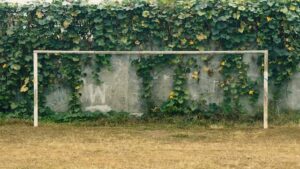Table of Contents
- What are the dimensions of a soccer goal?
- The history of soccer goalposts
- Are all soccer goalposts the same size?
- Are goalposts the same size in men’s and women’s soccer?
- Who is responsible for checking the size of soccer goalposts?
- Why is the soccer goal referred to as the woodwork?
- Recap: The dimensions of soccer goalposts
The dimensions of a soccer goal – what are they, and why are they sized as they are?
Well, the term ‘moving the goalposts’ is an adage suggesting that somebody is changing the rules as they go along.
If you’ve ever watched a professional soccer match, you’ll know it’s not as simple as that to change the goal’s size at the elite level.
But what should the dimensions of a goal be in the first place? Let’s examine the details of the goals within the beautiful game.
What are the dimensions of a soccer goal?
Goalposts at the professional level are to have inside dimensions of 24 feet across x 8 feet high.
There is no room for deviation in the size of the goalposts. Every goalpost must measure the same at the highest form of the game.
The width that the goalposts must be apart from each other were introduced in 1863 and have remained the same to this day.
It took 12 years after to introduce a crossbar at all (and it wasn’t even a bar then, just tape or string), but when it did come in, the rules stated it should be 8ft high, as it is now.
The history of soccer goalposts
In primitive societies, the materials used as goalposts ranged from sheets of fabric to a rival town’s church.
Measurements for the goalposts were first put into law 159 years ago. Back then though, there was tape or string where the crossbar is today. It wasn’t until a while longer for the sport’s governing bodies to eventually replace the tape with wood.
Ongoing furore regarding disputed goals that defending teams claimed hadn’t gone through the posts were being awarded as goals by referees.
This inspired the trial of goal nets, where the ball would nestle into should it have gone between the posts.
Look back on old footage and you’ve see squared goalposts instead of the smoother, rounded ones we have in place today.
Curiously, Scottish stadiums were stubborn and stuck with squared posts when nearly everyone else in Europe had switched to rounded goal frames. Fans of French club Saint-Etienne feel this is the reason they lost the 1976 European Cup final to Bayern Munich at Hampden Park.
They claim that if both of their best attempts, which hit the squared frame of the goal, had hit rounded posts instead, they’d have gone on to win the cup. We’ll never know for sure.
It wasn’t just the shape of the posts that was different either. The woodwork used to be… well, wooden! That’s how the term was coined and it hasn’t changed since, even when the materials were modified to become metal.
Are all soccer goalposts the same size?

In the professional game, all soccer goals must conform to the exact dimensions set by FIFA law. However, goal sizes can differ when the format changes or younger players are involved.
5-a-side, 6-a-side, and 7-a-side soccer is usually played with much smaller goals. Depending on where you play this format, either the goal’s width or height will reduce dimensionally.
Some 5-a-side, 6-a-side, or 7-a-side soccer leagues will have ‘head height’ restrictions, meaning the ball can’t go over the general height of somebody’s head. Therefore, these leagues would almost certainly have low crossbars but remain wide.
However, when those rules aren’t enforced, it gives the organizers flexibility to choose which dimensions they want to go with.
Goalpost sizes tend to be reduced at youth level as well. This is because it’s simply unfair to ask children who are goalkeepers to keep out shots with any success in an adult sized goal.
Before a child becomes a teenager, the goal sizes that will play with vary depending on the organizer of the game.In the UK, when youngsters are first introduced to 11-a-side soccer at the age of 13, they are recommended to play in goals that are 21 feet wide x 7 feet high. Once they are 15, they can play in full sized goals.
Are goalposts the same size in men’s and women’s soccer?
Yes, goals are the same size in men’s soccer and women’s soccer at a professional level. There has been some debate between commentators in the sport as to whether this should remain the case, however.
During the 2019 Women’s World Cup, France’s squad consisted of three goalkeepers, measuring 5’7”, 5’8”, and 5’9”. The logic behind calls to reduce the size of the goals for women comes from comparing these heights to the men’s goalkeepers’ heights at the time: 6’1”, 6’2”, and 6’7”, respectively.
While that argument rages on in the background, women and men do, in fact, play with the same sized goals.
Who is responsible for checking the size of soccer goalposts?
The match officials are ultimately responsible for checking that the goals in place are the correct size.
There was a strange instance this season in England’s second tier when Hull City faced Birmingham City.
Prior to the game kicking off, the referee and his assistants found that one of the goals at the MKM Stadium was too tall. In a rather unconventional move, ground staff found the best course of action was to saw the posts down to regulation size on the playing surface for all to see.
Although this is an extremely rare occurrence, it’s not even the first time that the goalposts have been noticed to be incorrect in that division this season!
Cardiff City manager Mark Hudson had suggested that the frames of either goal weren’t matching in size. The referee said that investigating the claim and resolving the issue could take 2 hours, so it was agreed by both managers that they’d play on considering they swap halves at half time.
Hudson complained about the size of the goal at one end of the field prior to kickoff, he couldn’t have imagined that the goalframe in question would’ve had a big part to play in the goal that would seal the victory for his side.
Why is the soccer goal referred to as the woodwork?
Rather than the metal frames that we see today, older goalposts were made of wood, hence the nickname.
As detailed in another of our articles, the availability and reliability of the fir meant football associations could use the wood at the professional level.
However, the term ‘woodwork’ was so ingrained in soccer parlance that it stuck even when the governing bodies switched to aluminium goalposts.
Recap: The dimensions of soccer goalposts
The goalposts might have changed in their material and shape over the years, but their dimensions have remained constant – 24 feet across x 8 feet high
Hopefully there won’t be much need for you to get the measuring tape and saw out the next time you attend a soccer match!

